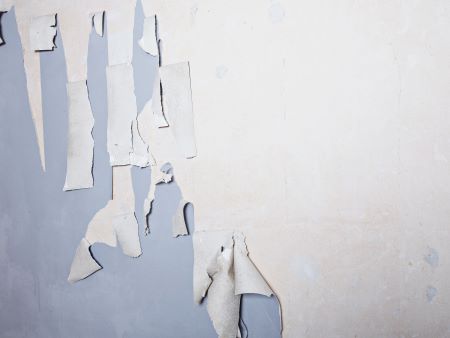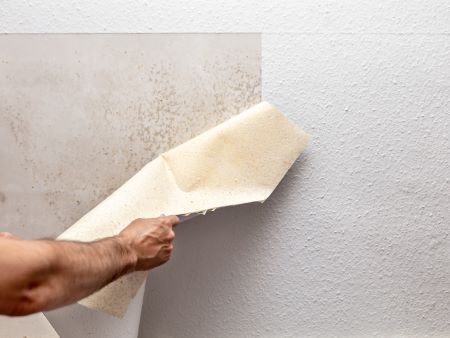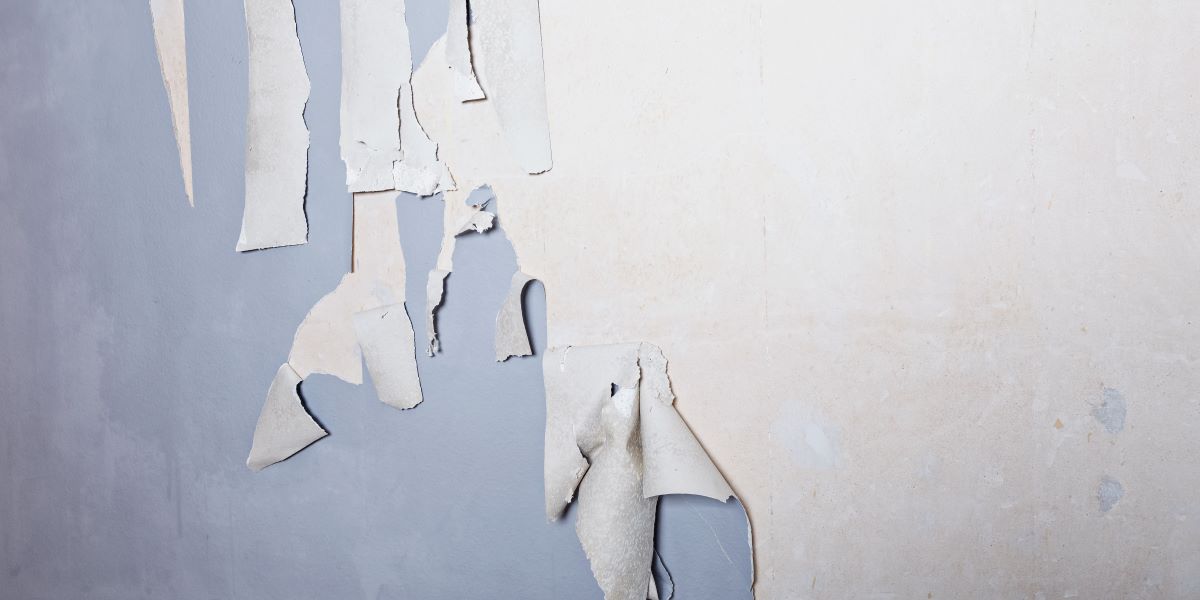It’s Time to Strip! Why You Should Always Remove Wallpaper Before Painting.

Stripping wallpaper is one of those projects that everyone dreads. They know it can be a tedious and messy process. It is only human nature to explore any options that will avoid this daunting task. As a result, one of the most common questions that we’re asked is, “Can I paint over wallpaper?”
The process of stripping wallpaper is fairly easy if all of the wall prep was done correctly before it was applied (not very likely). Unfortunately, you have no way of knowing until you actually get into the process. Therefore, the tendency is to avoid opening that can of worms. A seemingly logical solution is to leave it alone, pretend it isn’t there and paint over it. However, there are risks you run by attempting to paint over wallpaper.
So What is the Problem?
Adhesion Will Ultimately Fail
Wallpaper paste is water-based. Moisture from paint products will seep in around the edges and along the seams, compromising the integrity of the glue and weakening the adhesion. As well, in some cases, adding liquid will actually cause the paper to shrink. At this point, all of the laws of physics are against you. Moisture then causes wallpaper to bubble. If this happens, it may be possible to cut and peel the bubbled areas, “float” the damaged sections with drywall compound, and re-texture or re-paint. Or, it may be necessary to go back to square one and completely strip the wallpaper. And since the wallpaper has texture or paint on it now, this will likely be more difficult (and certainly messier) work then if the job started with completely removing the wallpaper as step #1. At this point, you have a bigger mess on your hands as well as wasted time and money spent painting.
Seams Will Be Visible
If you decide to roll the dice and take a chance… there’s still an issue of the visible texture and lines from seams. No amount of paint will hide that. It may be tempting to think about “skimming” or filling those areas to make them smooth. Once again, you are adding more water-based products directly over the places where the original wallpaper adhesion is the most vulnerable.
Skimming walls with any kind of texture will require numerous coats and sanding between each layer. If you’re going to all that trouble, you may as well strip the wallpaper and repair the walls correctly. Knowing that the job has been done correctly will allow you to sleep a lot easier at night.
Stress From Added Weight
Another risk with working over existing wallpaper is that the added weight of the new material being placed on top of it that may exert “shear” stress on the wallpaper glue. The glue was not meant to handle this extra weight and this can lead to the glue failing. The result will likely manifest itself as the wallpaper spontaneously peeling off the wall taking the new paint or texture with it. Or it may show up as bubbles or ripples on the surface. Again, the work to fix problems after the fact is likely greater than if the wallpaper had just been removed from the get-go.
Issues with Resale

Real estate professionals will be the first to tell you that wallpaper can negatively influence a buyer’s perception of a home. Even if it is replaced with a current design, you run the risk of not accommodating the potential buyer’s personal taste. No one is excited about facing the task of removing wallpaper.
A compromise to this dilemma is to eliminate the “difficult to change” factor. A painted wall finish is an option that can offer a stunning departure from plain paint to give a space personality. Patterns can be applied with water-based products that mimic the look of wallpaper. The advantage is that when you are ready for a change, they are easily transformed with a coat of fresh paint.
Final Thoughts
One “trick” that is often used when homeowners do not want to go through the trouble and expense of stripping wallpaper is to lightly prime over the wallpaper using a quick-drying oil-based “stain block” primer. This oil-based primer layer will give the wallpaper some protection against the water in the paint or texture compound soaking through to the glue. Once the wallpaper is primed, a light “float” with drywall compound smooths out the wallpaper seams. But it should be noted that this is not a guarantee against the problems discussed above.
If you are making an investment to upgrade your home, be sure to do it right. Your end result will only be as good as the surface you are working on, and skipping steps is bound to backfire.
Ultimately, the best solution is to completely remove the wallpaper and the underlying adhesive. Completely removing the wallpaper eliminates the possibility of bubbling or subsequent problems due to glue failure. In the long run, there will be less work involved, money saved, your walls will look amazing, and you’ll be thanking your future self for all the headaches you’ve avoided!
Let the experts at Zoe’s ProEdge Painting tackle your wallpaper removal project. We can make the process of returning your walls to a smooth and pristine surface quick and easy. Let us take on the mess for you! Give us a call today!

